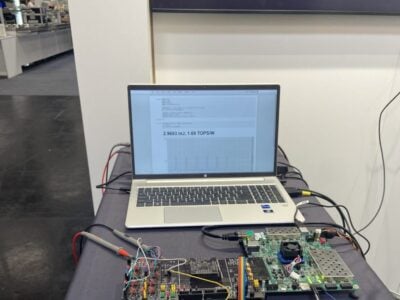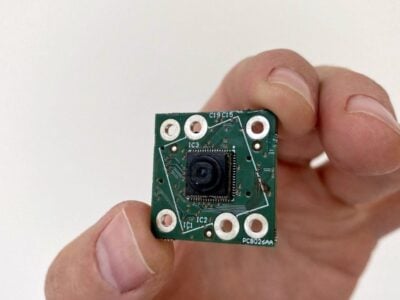
CEO Interview: Melexis rebuilds beyond automotive
Chombar helped create Melexis 25 years ago along with Rudi de Winter – who is her husband and who preceded her as the company CEO – and Roland Duchatelet who is chairman of the board of directors.
Over those 25 years the company has grown as a supplier to the automotive sector of Hall-Effect magnetic sensors, pressure sensors, optical and wireless chips and sensor interface ICs. In 2013 achieved annual sales of €275 million (about US$340 million) and a healthy net profit of €55 million (about $68 million). But despite what looks like it is going to be a good 2014, Chombar is keen to expand the company’s customer base further.
Melexis is a fabless chip company but it is part of close-knit family of companies. Xtrion NV (Tessenderlo, Belgium), a holding company founded by Duchatelet, has majority shares in both Melexis (53 percent) and X-Fab Silicon Foundries (59 percent). And Rudi De Winter is the CEO of both.
eeNews Europe sat down with Chombar during the Electronica exhibition and asked whether she was satisfied with Melexis being just an automotive supplier in a sector that was attracting more vendors and more competition.
"In 2013 automotive sector accounted for 87 percent of turnover. We still see automotive as our core market but we also see opportunities outside automotive, which is why we are working to expand out multimarket offering," said Chombar. "In the longer term we want to get back to the situation where we were; at 70 to 75 percent automotive." Chombar says she wouldn’t like to see non-automotive expand beyond about 30 percent of the business. "We have a very good technology base but the automotive customers like to see commitment to their market," she said.
The Melexis product range is broad and includes magnetic sensors, MEMS sensors, current sensors as well as image sensors. Of necessity Melexis has also become expert in the interface protocols required in automotive such as LIN. Although the LIN data rate is relatively low, and is being superseded in some applications, it is being used to add functionality such as ambient lightning, based on LIN-driven RGB LEDs, Chombar pointed out.
And Melexis has had a wireless business unit for more than ten years working on short-range connectivity and identification in the form of RFID, passive keyless entry, near-field communications (NFC) and tyre pressure monitoring systems (TPMS). In the optical field Melexis sells rain/light sensors, proximity sensors and even optical gesture recognition sensors for cockpit control. "According to Strategy Analytics we are ranked number five in automotive sensors worldwide," Chombar said.

Francoise Chombar, CEO of Melexis NV.
Chombar said that a great advantage of working in automotive is that places high demands on product development in terms of reliability and robustness. If products work in the automotive environment, they will likely be suitable for industrial, medical and white goods applications.
The company works with X-Fab as its main supplier. "We are fabless. We buy wafers and assembly services but we do test ourselves," said Chombar. "Many automotive circuits require calibration and so on. We use X-Fab and other foundries." But automotive IC manufacturing, particularly of sensors, relies on specialist manufacturing processes and is subject to extra layers of customer qualification and reliability testing, making changing suppliers difficult if not impossible, eeNews Europe said.
"We are their [X-Fab’s] number one customer and as long as they continue to meet requirements….but we also work with other foundries," Chombar responded.
Returning to the topic of Melexis’ need to diversify into sectors beyond automotive. Chombar stressed that this is not new but in essence is a rebuilding exercise.
"The pressure has always been there. The real reason we want to diversify is that we have been there before, before the crash of 2008/2009. Automotive is a demanding commercial environment and it is conservative. It takes a while to adopt innovative technology, but once it is adopted it can have long sales life. There is an opportunity to be ambitious outside automotive where the adoption of innovation is much faster."
Chombar makes the point that working outside automotive can help keep Melexis sharp in terms of technology innovation which that can then be transferred into automotive when customers are ready, and similarly automotive-grade components that are achieving high volumes can be leveraged into other sectors, that value reliability and robustness.
The different development and design-in times and product life cycles across multiple sectors make for a better-balanced company, Chombar indicated.
White goods, personal health
"In 2008/2009 [during the global economic crisis] we made the decision to focus on automotive. What we are embarking on now is a rebuilding exercise in terms of non-automotive customers," said Chombar, while acknowledging that is a different world as technology and applications have moved on.
"The energy-saving trend has been in automotive for a while but now it is coming to white goods. More and more sensors are being put in white goods. Similarly there are opportunities in personal health for which we have developed a contactless thermometer." Chombar also cites a pain-relief pad for the back based on blue LED lighting that promotes healing in the body. Melexis is providing temperature monitor for that as well as a temperature sensor for the airflow of a hair dryer.
Chombar said Melexis maintains its R&D spend at 14 or 15 percent of sales revenue and intends to keep on innovating. And dispelling thoughts that Melexis is just an analog, MEMS and sensors company she points out that the company developed its own microcontroller architecture, which now spans 8, 16 and 32-bit versions and has its own embedded flash manufacturing process.
Happy days and M&As
Although the competitive landscape is subject to change the outlook is bright at Melexis. Chombar said that the company and has a reasonable geographic spread of sales and is looking to achieve somewhere around 20 percent growth in 2014. "We have just under 40 percent in Europe, a bit over 40 percent in Asia-Pacific and about 17 percent in the US," she said.
That geographic spread more or less reflects the industry-wide spread of sales in automotive electronics, a field that is growing faster than the growth of the vehicle market, Chombar said. Nor is Chombar worried about declining sales in Europe. "Europe is very innovative as far as automotive is concerned."
However, that number five position in automotive sensors might be seen by some as marking Melexis out for potential acquisition by one of the larger automotive suppliers – Freescale, Renesas or STMicroelectronics – eager to achieve economy of scale advantages over their rivals?
Although Melexis is a public company traded on Euronext market the fact that Xtrion, a private concern, holds 53 percent of the stock does provide Melexis with a level of protection from takeover. And Melexis is itself not averse to doing acquisitions.
"In the past we have done some acquisitions. But they were generally of the small complementary IP type," said Chombar adding that it is likely to remain the model going forward. "There is plenty of organic growth potential in automotive and outside. There is no need to buy market share," Chombar concluded.
Related links and articles:
News articles:
Melexis shows software-defined 3D magnetometer
Image sensor targets driverless cars
AMS wins magnetic sensor patent ruling against Melexis
Supply chain is cause of automotive woes, says Melexis
 If you enjoyed this article, you will like the following ones: don't miss them by subscribing to :
eeNews on Google News
If you enjoyed this article, you will like the following ones: don't miss them by subscribing to :
eeNews on Google News




